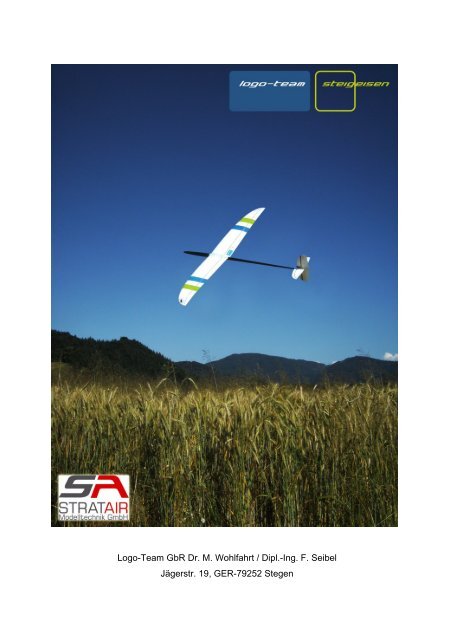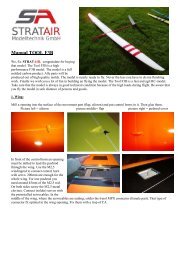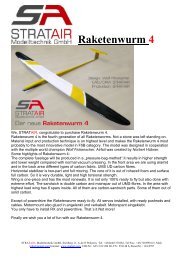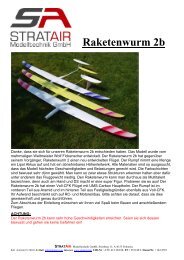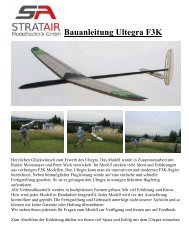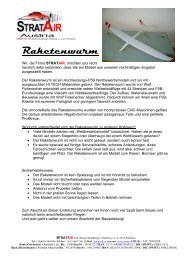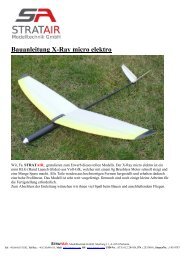Logo-Team GbR Dr. M. Wohlfahrt / Dipl.-Ing. F. Seibel ... - Stratair
Logo-Team GbR Dr. M. Wohlfahrt / Dipl.-Ing. F. Seibel ... - Stratair
Logo-Team GbR Dr. M. Wohlfahrt / Dipl.-Ing. F. Seibel ... - Stratair
- No tags were found...
You also want an ePaper? Increase the reach of your titles
YUMPU automatically turns print PDFs into web optimized ePapers that Google loves.
<strong>Logo</strong>-<strong>Team</strong> <strong>GbR</strong> <strong>Dr</strong>. M. <strong>Wohlfahrt</strong> / <strong>Dipl</strong>.-<strong>Ing</strong>. F. <strong>Seibel</strong>Jägerstr. 19, GER-79252 Stegen
1 IntroductionThe Steigeisen was designed by <strong>Logo</strong>-<strong>Team</strong> to meet your highest demands as aDiscus Launch Glider. Excellent penetration characteristics when returning from adownwind run. Superior launch heights. Nice handling in thermals. We spent muchtime with testing all details to offer you a state of the art high-end glider for F3Kcompetition flight. The <strong>Logo</strong>-<strong>Team</strong> went beyond current thinking with its design targets.The result is an extremely strong lightweight fuselage with a horizontal elliptical crosssection. The mount point for the fin is molded as part of the fuselage ensuring perfectvertical alignment. The horizontal-tail is an all flying stabiliser. Fixing the horizontal-tailtakes a matter of seconds and a micro ball bearing gives you precise and direct controlinputs in conjunction with carbon pushrods inside of teflon tubing. No moretemperature drift of your linkages and an absolute repeatability of decalage are theresults. Enjoy building and flying your Steigeisen.1.1 Limit of liabilityYour Steigeisen has been constructed and built to the highest standards. Regardlessof construction and manufacturing your personal craftsmanship will determine theairworthiness of this glider. <strong>Logo</strong>-<strong>Team</strong> and <strong>Stratair</strong> will not take any responsibility forthe usage of your glider. By keeping your Steigeisen you confirm that there are nostructural damages and it is fit for purpose as received. Never launch in the direction ofother people. Fly responsibly and make sure your third party liability insurance is valid!1.2 Aerodynamic conceptThe biggest increase in aerodynamic performance comes from the new airfoil. It had tocompete with the new Salpeter as well as the AG455ct-series from <strong>Dr</strong>. Mark <strong>Dr</strong>ela. Thenewly developed wing sections WO322-WO325 get their performance by a balancing actbetween excellent launch height and penetration as well as an excellent rate of descent.Good penetration characteristics have become more and more important as most of F3Kcompetitions take place downwind nowadays. To further improve these penetrationcharacteristics at moderate airspeeds the aspect ratio was increased slightly. As a resultwing loading can be slightly higher to achieve a better lift/drag ratio. At low airspeeds thelower induced drag makes up for the higher wing load. What else can be done to getbetter launch heights? Simple geometric considerations said that the launch peg neededto be as far backward as possible. To fully understand this we analyzed the launch phasewith high speed cameras as well as a computer simulation. Both showed that our simpleconsiderations had been correct. To translate this launch peg lag into reality the winggeometry is slightly swept back. This results in nice handling characteristics as a sideeffect. Thermaling with the Steigeisen is a joy. Little aileron is needed to support in turningflight.The elevator was designed as an all flying stabilizer. The main characteristics are advan-3
tages in drag when deflecting the elevator as well as in trimming the glider. In addition tothis the flight characteristics are very obedient. When you look at the position of theelevator compared to a regular F3K setup you will find that its position is far more towardsthe tail. This will improve dampening of pitch axis. As a result we were able to reduce thesurface area of the elevator.1.3 ConstructionOur experience with the Kohlibri fuselage (the predecessor of the Steigeisen) in thepast has not always been the best. Most F3K pilots have had broken tailbooms orproblems when installing the RC-equipment. With the Steigeisen we made a fuselagelike a unified whole. It is a single piece part with no reduction in cross section at thewing mount. Why reduce stiffness where you have the highest bending moment? Whyoverlap the increase of pressure of the wing with the one resulting from the fuselageby lacing it in? The width of the Steigeisen fuselage is smooth and homogeneous andcomes from a laminar body designed for a moderate gliding cL. The cross section ofthe boom is a horizontal ellipse and fits to the bending moment of the lateral forces.In the front you will find enough space to fit four servos DS281 without a set of surgicalinstruments. Using a 2,4GHz receiver is no problem. The canopy is at the bottom and isbig enough to reach all servos the receiver and the accumulator. The fuselage opening isplaced underneath to make it possible that the flaperon connection runs straight andwithout complications. You can retrofit a ballast system. No removal of the wing isnecessary to position the copper rod. By this practically orientated system you can varywing load at short notice. After autoclave production every single fuselage is tested with4kg at the tail and 8kg in the front!It looks scary, yes. On the left picture you can see a standard tailboom (e.g. Kohlibri) withonly 2kg load. The Steigeisen wing is built in standard sandwich technology with Rohacellas sandwich material out of CNC milled molds. You can choose between a variety ofdifferent versions. UHM Disser, full carbon and carbon D-Box or the D 2 (Disser+D-Box) forinstance. The tail unit is made out of glass with a Rohacell core resulting in light weightand, for F3K standards, good toughness.4
1.4 RC-components and equipmentWe recommend to use the following RC-Components:Receiver: Schulze alpha/delta, SMC-16 scan (w/o case), Futaba FASST 607 (w/ocase). Other, similar 2,GHz RX can be also used.Flaperon servos: Graupner DS281, DS285, C261 or C271. Hyperion Atlas DSC09(remove bottom case and secure servomotor with some shrink)Horizontal stab.: Atlas SCD09 / Graupner DS281Vertical stab.: D47 DymondBattery: 4 x GP 350-400mAhTo check your launching height try the LoLa micro altitude recorder by STRATAIR. It´sonly an additional 2,8g and will help you improve your launching technique a lot.5
2 Completing the SteigeisenHere we go! Make sure to read the instructions carefully. Take your time, you should bedone in about 6h, depending on your personal experience in RC modeling. If there are anyquestions send an email. Upon receiving your Steigeisen you should have the followingparts: wing fuselage with canopy elevator, ø0,5mm steel pushrod for elevator 1m rudder, ø0,7mm carbon pushrod for rudder 1m ø3/2mm carbon rod for flaperons (180mm & 150mm) ø2mm carbon rod 100mm (for connection ball pan to ø3/2mm carbon rod) bell crank for elevator with micro ball bearing ø2,5mm ø2,5mm carbon rod 65mm for elevator / ø1,5mm carbon rod for elevator35mm sticker <strong>Logo</strong>-<strong>Team</strong>, sticker StratAir threaded bar (to be cut into two halves), M3 socked screw 2x 2x M3 screws for wing-fuselage mounting 4x ball end, 4x ball panAdditional if ordered: wing & rudder protection covers throwing peg power ballast system (up to 85g!)2.1 wingWhen handling the wing make sure that no sharp edged objects are around. I use anold towel or bubble wrap on my work bench to protect the wing form scratches und6
dents. An even better choice are the wing covers provided by <strong>Stratair</strong>.comMaking the levers: Push the flaps down and use some 5min Epoxy with cotton toreinforce the area where the steel rods enter the flap. Be careful not to get glue intothe hinge. If this makes the sealing lip stick out remove the affected tape and replaceit. To take the sticking away from the tape use some microballons. Cut the threadedbar in half. <strong>Dr</strong>ill out cut end with a 2mm bit -screw the ball end on and use it to stop thedrill going too deep. The bar is not hollow so make apilot hole first and then use the 2mm bit. Remove theball and give the drill a couple more light turns tomake the lever fit on the rods better. The rods in thewing need a little fettling with a file to get the levers toseat properly, this also roughens them up for gluing.Glue the levers on to the rods with epoxy resin, takecare not to glue the balls in the levers as these willneed to unscrew to remove the wing from thefuselage. Make sure they have the same length andfit in extension of the steel pin. Overall length shouldbe 14mm including the ball. Due to productionprocess you might have to shorten the steel pins alittle before gluing the rods. To connect the flaperonswith the trilerons use Silicon in-between or a piece oftape connecting the trailing edge.2.2 Throwing pegFigure 2.3 shows you how we recommend to fit the peg. If you prefer a different positiongo ahead. Just avoid to choose an extreme off-set from the recommended position, asstiffness will reduce quickly when moving away from the reinforced position too much. Thepeg is available from StratAir as well. It was specially designed for maximum powerlaunches without causing sore finger tips. The trailing edge of the peg is rounded and thetips are drawn up to prevent slipping.7
Mill a hole at the designated position.The peg can be installed in two different ways. The leading edge facing direction offlight (or the trailing edge). I prefer to have the bigger nose radius as the trailingedge. This will protect your fingers.Use a grinder to achieve a snug fit of the peg. It is very essential that there are nogaps between the peg and the wing.Glue with CA. Make sure to harden the area around the peg using CA as well.2.3 Fuselage Put all servos into shrink tubing. Roughen the tubing after shrinking process with240 grit sanding paper. Battery fits best in a two by two configuration. Offset / Neutralise all servos as desired. Flaperon servos should have 15 ◦ offset tomaximize downward deflection for better braking characteristics Make a servo tray from 2mm balsa wood with the dimensions as sketched.To give extra strength to the balsa tray soak it with CA, spread the CA over the traywith a piece of cut up credit card.8
Glue the servo tray into the fuselage with five minute epoxy Place the battery in the far most front position. Slide the receiver a little over thebattery. Position the rudder servo so that you can still remove the receiver bysliding it over this servo. Mark this position on the servo tray. Place the elevator servo just behind the rudder servo. Mark this position as well. Make an opening in the fuselage where the two steel pins from the wing pointinto the fuselage. Make it as small as possible but as big as necessary. <strong>Dr</strong>ill twolittle service holes into the bottom side, to be able to mount/unmount the wing.Use CA to avoid carbon fray out.9
Prepare the two carbon pushrods as shown. Also glue the 2mm carbon rod tothe servo ball point. Take sanding paper and sand the 2mm carbon rods untilthey slide into the pushrod really easy. Screw the ball joint with the 2mm carbon rod to the flaperon servos with an M2hex key. Take the second hole of the longer servo arm (C261, C271, DS281).Glue the two aileron servos with five minute epoxy to the servo tray just behindthe elevator servo. Make sure to have full travel. Mount the wing on the fuselage. If it fits too snug use sanding paper on thevertical area at the trailing edge. If still necessary also sand the leading edgearea. Also mount the carbon pushrods with the ball joint through the two service holeswith an M2 hex key. Make sure to mount the longer carbon pushrod on the sidewith the further forward positioned aileron servo. Be patient! Once the carbonpushrods are attached to the flaperon servos it´s a lot easier. Slide the 2mm carbon rods into each pushrod. If necessarry move the flaperonsupward to make this step easier and/or shorten the 2mm carbon rods a little bit. Take a little piece of tape and fix both flaperons in neutral position. Glue the 2mm carbon rod into the carbon pushrod with thin CA. Unmount the wing.2.4 Tail planesThe next step before continuing with the rudder and elevator servo is the tail unit. The 2,5mm carbon will hold the split all flying stab. The carbon needs to be a snugfit when pushed through the micro ball bearing. If necessary use 600-1200 gritsanding on the carbon rod. Be very careful not to take off too much! Just enoughso that the carbon has the described snug fit. The joints for the piano wire to carbon pushrod can’t be too long or the elevatormay end up with limited movement.10
Glue the bearing into the bell crank. Push the 2,5mm carbon rod through the pocketand the micro ball bearing. Centre the rod and the horn/bearing. Using a needle orpin put some small drops of CA to both sides of the connection: pocket-bar andbar-ball bearing. After you are done make sure the bell crank can be easily movedby pushing/pulling the carbon pushrod from the cabin.insert the 1,5mm carbon rod centered into the bell crank.Slide the elevator halves on and check for free movement by pushing/pulling thecarbon pushrod from the cabin.check for correct alignment and glue the 1,5mm carbon rod to the bell crank.Make a z-bend on the opposite end and glue the servo with 5min epoxy to theservo tray. Elevator should have approximately 1,5 ◦ AoA when fixing position of theservo and length of the pushrod11
Check that carbon tube is exactelly between the aileron pushrods The carbon tubehas to be glued in the canopy are (see picture above) and the other end has to befixed just under the the wingarea. That means the carbon tube is diagonal in thefuselage. So you are able to remove ballast easily. For glueing at the endpart of theballast tube drill a small hole on bottom side of the fuselage. There you can insertsome 5min epoxy for glueing ballast tube with fuselage. Check afterwards that aileronpushrods run easy.3 Flying the SteigeisenCongratulations! Now comes the fun part. We recommend to begin with the given Centerof Gravity and throws. As you become more familiar with your Steigeisen you can changethem to your personal comfort. Start off with a forward CG.3.1 C.QCG-Range for the Steigeisen is: 73 +/-1mm from the leading edge. After the first few flightsthe Steigeisen should also be balanced laterally. Start to tape little lead pieces on the wingtip opposite to the throwing peg. Once you are satisfied take off all the lead and put it on ascale. <strong>Dr</strong>ill a small hole in the wing and inject just as much resin/microballons mixture asthe weight of the lead. Be careful not to have resin running into your flaperon hinge. Closethe drilling hole with a piece of tape. You will reinforce the tip while achieving a smoothsurface with no bulky lead pieces sticking on your wing. Peel off the tape after the resinhas cured.13
3.2 ThrowsFor best results in F3K Competition Flight as well as pure joy, it is essential to use thewhole potential of your Steigeisen. The Flying characteristics can be separated intothree flight phases: FP1/Launch: lift-coefficient slightly >0 FP2/Distance/Cruise: gliding flight in a wide speed range with cl from 0,1 to cAmax FP3/Thermal: flight with lowest decline within thermals or in dead air conditionsYou need to be able to at least program these three phases. FP1 and FP3 are fixedvalues. Flight Phase 2 is intended to cover the the whole speed range. The easiest way tosucceed is by using a sliding controller (speedcontrol) on your transmitter. It controls flapsas well as elevator at the same time. Imagine this speed control being your acceleratorpedal in a car! Adjust the neutral position of the elevator for straight and level flight (flighttest). You should come up with 1,5 ◦ AoA. All elevator throws refer to this neutral position(*). Positive throws refer to downward deflections and vice versa. Throws are measured inmillimeters at the root.3.2.1 Flight phase 1:14
3.2.2. Flight phase 2:3.2.2. Flight phase 3:15
The settings of Flaperons as well as the correlative elevator throw in Flight Phase 3 havebeen optimized in time-consuming test series. You will achieve best aircraft performanceby accurately using the measured throws. Try to avoid flaperon throws >3mm! FP3settings for minimum rate of descend can be checked fairly easy. You will obtain best rateof descend with a flaperon deflection of 2,5 to 3mm combined with an elevator trim forminimum speed (depending on C.G.). The easiest way to find this elevator setting is byflight test. You have to much elevator if your Steigeisen is stalling, or if too much aileron isneeded for corrections. By flying too fast you will increase rate of descend noticeably.Nevertheless this is a theoretical calm air setting. Flying in turbulent air always takes moreairspeed. Depending on weather conditions you need to adjust flaperon trim (together withelevator trim) a little.It is possible to achieve 0,33m/s rate of descent in perfectly calm conditions with a flightweight of 280g. This should give you 2:30 min out of 50m. For braking a downwarddeflection of up to 45mm is used. To compensate for diving moment add about 3-5mm upelevator (fine tune in flight-test and to your personal comfort). With brakes deployed addmaximum combi-switch to compensate for bad aileron response.3.3 First flightCheck your glider carefully before launching for the first time. Make a normal javelinlaunch, glide path should be straight and level. Correct all trims before launching via DLGtechnique for the first time. Don´t forget to switch to launch mode (which you havechecked prior, too)! One word needs to be said about accumulator running time.Depending on how many Digital Servos you are using safe flying time is reduced to 30-45min with a 350mAh battery. So don´t forget to charge in time.3.4 MaintanceFor long lasting life of your Steigeisen you should always handle it with care. Even thoughevery single fuselage is tested don´t stress the structure by locally applied forces (pressingwith your thumb e.g.). The Steigeisen fuselage will withstand your launches, don´t worry.Use the wing bags/covers when not flying. They have a heat reflecting surface and willalso protect your wing from dents. Most damages occur not while flying, but in yourworkshop or on the way to your car. Store your glider in a dry and cool place. Hot cars arenot appropriate. We would love to hear about your experiences with the Steigeisen. Sendus your pictures as well as your suggestions for improvement. We will try to translate theminto action. What comes next? We are working on a new RDS technology, Kevlar wings,an Electric Version and Prepreg TechnologyFlorian <strong>Seibel</strong>, Michael <strong>Wohlfahrt</strong> Mai 200916


